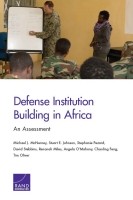| 来源类型 | Research Reports
|
| 规范类型 | 报告
|
| DOI | https://doi.org/10.7249/RR1232
|
| ISBN | 9780833092403
|
| 来源ID | RR-1232-OSD
|
| Defense Institution Building in Africa: An Assessment |
| Michael J. McNerney; Stuart Johnson; Stephanie Pezard; David Stebbins; Renanah Miles; Angela O'Mahony; Chaoling Feng; Tim Oliver
|
| 发表日期 | 2016
|
| 出版年 | 2016
|
| 页码 | 196
|
| 语种 | 英语
|
| 结论 |
- Understanding how to tailor programs to specific conditions of partner nations, gaining buy-in from partner leadership, incorporating civil society considerations, and establishing monitoring and evaluation techniques should greatly improve DIB effectiveness. We found little evidence these best practices were being systematically documented to support DIB planners.
- Formal guidance is insufficient and communication is overly ad hoc, given the complexity of DIB and how it relates to security cooperation more generally.
- DIB is a stepping stone to other U.S. defense objectives in Africa. Planners often fail to understand the important linkages between DIB objectives and other U.S. objectives.
- Significant resource and legislative constraints inhibit the United States from effectively applying security sector reform and DIB lessons.
- OSD and AFRICOM officials disagreed on DIB priorities and even the definition of DIB. In part because of different understandings of DIB and in part because DoD planners did not consistently document activities, monitoring of activities was uneven. Coordination challenges among OSD, AFRICOM, and others led to ineffective articulation of requirements, poor communication of DIB opportunities to African partners, poor understanding of partner interests, and insufficient substantive or regional expertise.
- There are more DIB-related programs (47) than is generally thought. DIB can be implemented through a variety of activities, including sending of advisors, needs assessments, education, information exchanges, and personnel exchanges. Such variety provides options for implementing DIB even with sensitive partners. Strengthening DIB efforts in Africa does not require creating new programs but rather focusing existing programs in this direction.
|
| 摘要 |
- DoD should develop a DIB best practices briefing tailored to Africa. This briefing could address strategic guidance and best practices.
- DoD leaders should work with Congress to address the need for additional DIB-related resources and to facilitate whole-of-government, long-term DIB efforts.
- DoD should develop a security cooperation playbook with a prominent section on DIB, written in simple language describing how DIB supports other U.S. objectives and how it can be used with African partners. The playbook would help planners coordinate activities and communicate with African partners.
- AFRICOM should develop guidance for country desk officers to consistently coordinate DIB planning efforts across the command and country teams. This would help harmonize DIB-related objectives in country-level plans.
- AFRICOM should strengthen its DIB coordinator office and institutionalize an annual DIB conference.
- DoD should set up a DIB enterprise liaison at AFRICOM as part of AFRICOM's DIB coordinator office.
- DoD should include a DIB familiarization module in its Defense Institute of Security Assistance Management Course and by having AFRICOM institutionalize in-house DIB training. Such training should improve understanding of how these many different programs can be employed toward DIB and how to integrate them with other security cooperation activities.
- DoD should organize a pilot effort in a single African country to serve as a model for future DIB activities, including a five-year DIB plan developed by U.S. and partner stakeholders. The plan would be based on a comprehensive baseline assessment conducted jointly with partner nation and international officials.
|
| 主题 | Africa
; Capacity Building
; Civil-Military Relations
; Operational Readiness
; Security Cooperation
|
| URL | https://www.rand.org/pubs/research_reports/RR1232.html
|
| 来源智库 | RAND Corporation (United States)
|
| 引用统计 |
|
| 资源类型 | 智库出版物
|
| 条目标识符 | http://119.78.100.153/handle/2XGU8XDN/108219
|
推荐引用方式
GB/T 7714 |
Michael J. McNerney,Stuart Johnson,Stephanie Pezard,et al. Defense Institution Building in Africa: An Assessment. 2016.
|
|
文件名:
|
x1495316194453.jpg
|
|
格式:
|
JPEG
|

|
文件名:
|
RAND_RR1232.pdf
|
|
格式:
|
Adobe PDF
|
除非特别说明,本系统中所有内容都受版权保护,并保留所有权利。